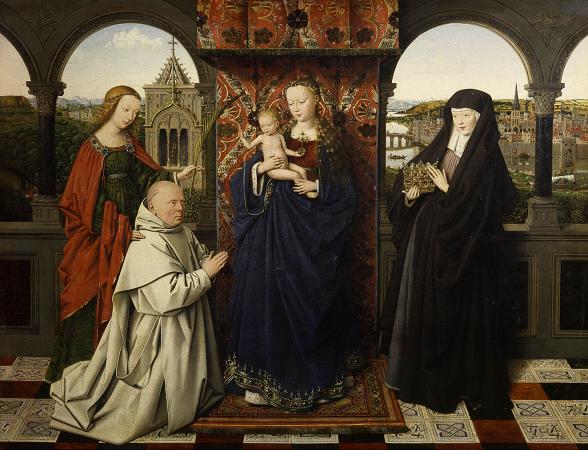Frick Collection. Occupying the lavish Gilded Age mansion of industrialist Henry Clay Frick, the Frick Collection offers an intimate encounter with European art from just brfore the Renaissance to the early 1900s. While Frick's business practices remain controversial, his decision to bequeath his mansion and art collection to the public in 1919 established a renowned museum. Early works in the collection include Cimabue's Flagellation of Christ (c1280) and Duccio's Temptation of Christ (c1310). Notable Italian paintings from the 15th century are Crucifixion by Piero della Francesca (c1458) and Saint Francis in Desert (c1480) by Giovanni Bellini. 16th century paintings at the Frick include Deposition (c1513) by Gerard David, Man in Red Cap (1516) by Titian, Portrait of Lodovico Capponi (c1553) by Agnolo Bronzini, and Three Soldiers (1568) by Pieter Brueghel the Elder. The Frick has two 16th century portraits by Hans Holbein the Younger, Thomas More (1527) and Thomas Cromwell (1533). The museum also has two El Greco paintings, Portrait of Vincenzo Anastagi (c1574) and Purification of Temple (c1600). Beyond its stunning paintings, the Frick Collection enlivens the New York cultural scene with lectures, chamber music concerts, and special exhibitions, inviting a deeper appreciation for the art and its grand architectural setting. Henry Frick started his substantial art collection as soon as he started amassing his fortunes. A considerable amount of his art collection is located in his former residence Clayton in Pittsburgh, which is today a part of the Frick Art & Historical Center. Another part was given by his daughter and heiress Helen to the Frick Fine Arts Building, which is on the campus of the University of Pittsburgh. The family did not permanently move from Pittsburgh to New York until 1905. Henry Frick initially leased the Vanderbilt house at 640 Fifth Avenue, to which he moved a substantial amount of his collection. He had his permanent residence built between 1912 and 1914 by Thomas Hastings of Carrere and Hastings. He stayed in the house until his death in 1919. He willed the house and all of its contents, including art, furniture, and decorative objects, as a public museum. His widow Adelaide Howard Childs Frick, however, retained the right of residence and continued living in the mansion with her daughter Helen. After Adelaide Frick died in 1931, the conversion of the house into a public museum started. John Russell Pope altered and enlarged the building in the early 1930s to adapt it to use as a public institution. It opened to the public on December 16, 1935. Various additions to the architecture and landscape architecture of the museum site have been considered over the years including the placement of a prominent magnolia garden from the 1930s. As stated by the museum announcements: As a result of a decision of the Board of Trustees in 1939, three magnolias were selected for the Fifth Avenue garden. The two trees on the lower tier are Saucer Magnolias and the species on the upper tier by the flagpole is a Star Magnolia. Further expansions of the museum took place in 1977 and in 2011. In 2014, the museum announced further expansion plans, but came up against community opposition because it would result in the loss of a garden.
more...














